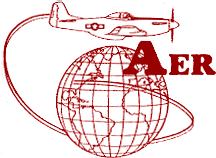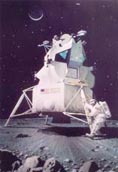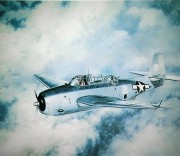|
Hans Weise is an executive producer at yellowbricks.com. His article first appeared in the Washington Post “Style” section, and he has graciously permitted us to reprint it here. Itīs a great story about getting started in aviation and what it takes to be a private pilot today. --Ed.
Wheels Up and a New Guy at the Controls
By Hans Weise
On the Washington Sectional Aeronautical Chart, Freeway Airport in Bowie, Maryland (so named for its proximity to Route 50) is a small magenta dot you can cover with a navy bean. To the left and above are broad splashes of lemon yellow outlined in black that represent metropolitan Washington and Baltimore. Below, a blue rectangle signifies Andrews Air Force Base.
I'm driving out to Freeway at early on a Saturday morning to continue private pilot training. It's a perfect day for flying: light breeze, cool, stable air. The Cessna 172 -- a 4-person, high-wing aircraft -- sits in the parking area. The 172 is great for its stability and the punishment it can take as a trainer, and its basic design hasn't changed in decades.
At 7:30, the small airport is already abuzz with activity -- instructors meeting students, pilots talking over polystyrene cups of bitter coffee. Coins clink in a can next to a tray of donuts. There
are faded pictures of airplanes on the walls and a stack of old Flying magazines on a table by the couch.
Pilots talk with their hands. They can't help it...
Pilots talk with their hands. They can't help it. Ask about a particular maneuver -- turning, climbing, traffic patterns -- and a hand shoots out at eye-level, banking and turning like a wing to show the effects of particular control inputs. Ask a pilot about his or her plane and you've got some good stories. Ask about the weather and you've got a conversation.
This morning, my instructor calls to cancel. I tell myself that this is an important lesson to learn -- that many times as a pilot I’ll plan a trip only to be stymied by traffic, late passengers or lousy weather. Becoming a private pilot is largely about frustration so you need to be a little obsessed with the idea to keep going.
It’s true. I’m obsessed. To get a license I’ll have to complete ground school and take the FAA written exam. Then a medical check, an oral test, spend at least 40 hours in the air, followed by a check ride and then, if I pass, I’ll be a VFR (Visual Flight Rules) pilot, which allows me to fly only in good weather. Back to Top
Ground school began one Tuesday evening in a small classroom attached to the main building when Fred Gibbs walked through the door – barrel-chested, mid-fifties, short gray-brown hair. He’s been flying for 26 years and teaching for 23. There’s a hint of William Shatner in his swagger. Fred says hello and fills the white board with airfoils, radio beacons, angles of attack and weather systems. He owns his own plane.
Don is the only one who has flown before—he piloted B-29s in World War Two. He’s 74....
I ask him what kind of person becomes a pilot these days. “It’s a broad cross section,” he says, “pretty much like the people in class.” There are five students including myself. Kevin works for a state senator in Maryland; Seth, in the Air Force, grew up in the back seats of his uncle’s plane in Alaska; Carmel, 44, works in the healthcare industry and “needed a diversion from an intense job,” and Don, who’s wife gave him flying lessons last Christmas. Don is the only one who has flown before—he piloted B-29s in World War Two. He’s 74.
Don says, “I watched George Bush jump out of that plane with a parachute a couple years ago and saw that old guys could still do things.” Don’s gray hair is combed straight back and he usually covers it with a NASA baseball cap. Being retired, he spends more time studying and flying during the week than the rest of us. Despite having flown B-29s. he says the experience doesn’t make flying small planes any easier. “That doesn’t make any difference,” he says. “You forget everything from that long ago. Gotta start fresh.”
With a good economy, “more people are coming back to [civil aviation],” says Fred. Freeway churns out maybe a few hundred pilots every year and I ask about flying over Washington. “It demands more knowledge,” he says, “The airspace is more complex,”
The airline industry is filling the skies with more flights and the amount of traffic the three major airports receive has grown exponentially, making time and space hyper-valuable resources.
Sitting on top of Reagan National, Dulles, and BWI are 10,000-foot cylinders of air and the pathways that connect these cylinders to those in, say, New York look like giant hamster mazes. To navigate in Washington’s Class B airspace you need experience, permission and a willingness to do what Air Traffic Control tells you to do. Back to Top
In my car, I use maybe two gauges while driving. In a 172 there are more than a dozen....
In my car, I use maybe two gauges while driving. In a 172 there are more than a dozen. The main set—a six-pack of gauges just below eye level—are the important ones: the altimeter, airspeed indicator, attitude indicator, turn coordinator, heading indicator and vertical speed indicator.
Going through the preflight checklist I can’t see which switches are which because for one thing, the labels are worn off from 20 years of use. My instructor, Brad, points to one mystery knob and says, “strobe light.”
I prime the engine, turn the key and suddenly everything in front of me is jiggling—the attitude indicator, the engine gauges and the fuel gauges are bouncing all over the place. I talk to Brad through the intercom in my headset. It’s tight in this plane and my left knee knocks the door latch open.
Steering with my feet takes some getting used to. I push the left pedal to turn left and the right pedal to straighten out. I add power with my right hand, using a black knob. Brad tells me to head for runway 18 and hold short where we’ll go through run-up—the process of revving the engine to check oil pressure, the magnetos, the suction, etc. The minute I push the throttle, the jiggling sends my checklist to the floor. I pick it up and hit the door latch with my knee again.
Brad says, “Let’s wait for this guy,” and he points out the windshield at another Cessna on final approach. It lands smoothly. Freeway has no control tower so Brad says, “Say, ‘Freeway traffic, Cessna two-six-six, taking off runway one-eight, departing to the East.”
I repeat the words carefully. I’ve been warned already about mike-fright—the tendency of student pilots to forget everything the moment they click on the transmit button. In my case, I remember the words and forget the button.
I roll us onto the runway, putting the nose wheel on the center line. Flaps up, throttle to full. It’s now that I notice how tall the trees look at the end of the runway. A wall of green. Who in his right mind flies here? Back to Top
There’s a weird intimacy in a small plane. Shoulder to shoulder, speaking quietly through headphones while defying the tendency aluminum has to plummet....
At 60 knots, the plane takes off. As we clear the trees, we start bouncing around up to 1,400 feet heading for Chesapeake Bay just south of Annapolis. At 1,500 feet we’d be entering Andrews Air Force Base airspace.
There’s a weird intimacy in a small plane. Shoulder to shoulder, speaking quietly through headphones while defying the tendency aluminum has to plummet.
Out over the bay I practice turns for about an hour: steep turns, climbing turns, descending turns.
I bank to the West watching the heading indicator turn clockwise. The sun is low in the sky and we can see traffic for BWI above us on either side. We fly into the sun over Lee airport, near Annapolis, and begin entrance into Freeway’s pattern. Getting ready for landing is a multi-tasker’s dream. Or nightmare. I don’t have time to look down at my checklist, the instruments, and the sky outside but Brad assures me that at some point, like riding a bike, you just “get it.”
Among the things you have to think about: other traffic, airspeed, altitude, rate of descent, flaps and your distance from the runway.
From 1,000 feet, Freeway’s runway looks like a country lane—a tiny strip of pavement 30 feet wide and less than 2,500 feet long. Tall power lines stand north of the airport.
Fred said once that flying is the second most thrilling thing you can do and that landing is the first.
My heart’s beating fast and I realize that on top of it all, I’m supposed to communicate with the traffic around me. “Cessna two-six-six turning onto base leg…”
At this point, Brad resumes control and has me follow along with my hands on the wheel. Traffic on route 50 rolls beneath us. Just before the threshold, I pull power back to idle and tip the nose up slightly to bleed off speed while we settle onto the runway. With a bump, we roll to a stop and taxi to the parking area.
Brad scribbles a few remarks in my logbook.
That night in ground school, we discuss the FAA test -- weight and balance, wind correction angles, fuel calculations. There are many flights yet to go and I remember a bit of folksy pilot wisdom I overheard one afternoon: A good flight lesson ought to be like a skirt—short enough to be interesting but long enough to cover everything.
|


